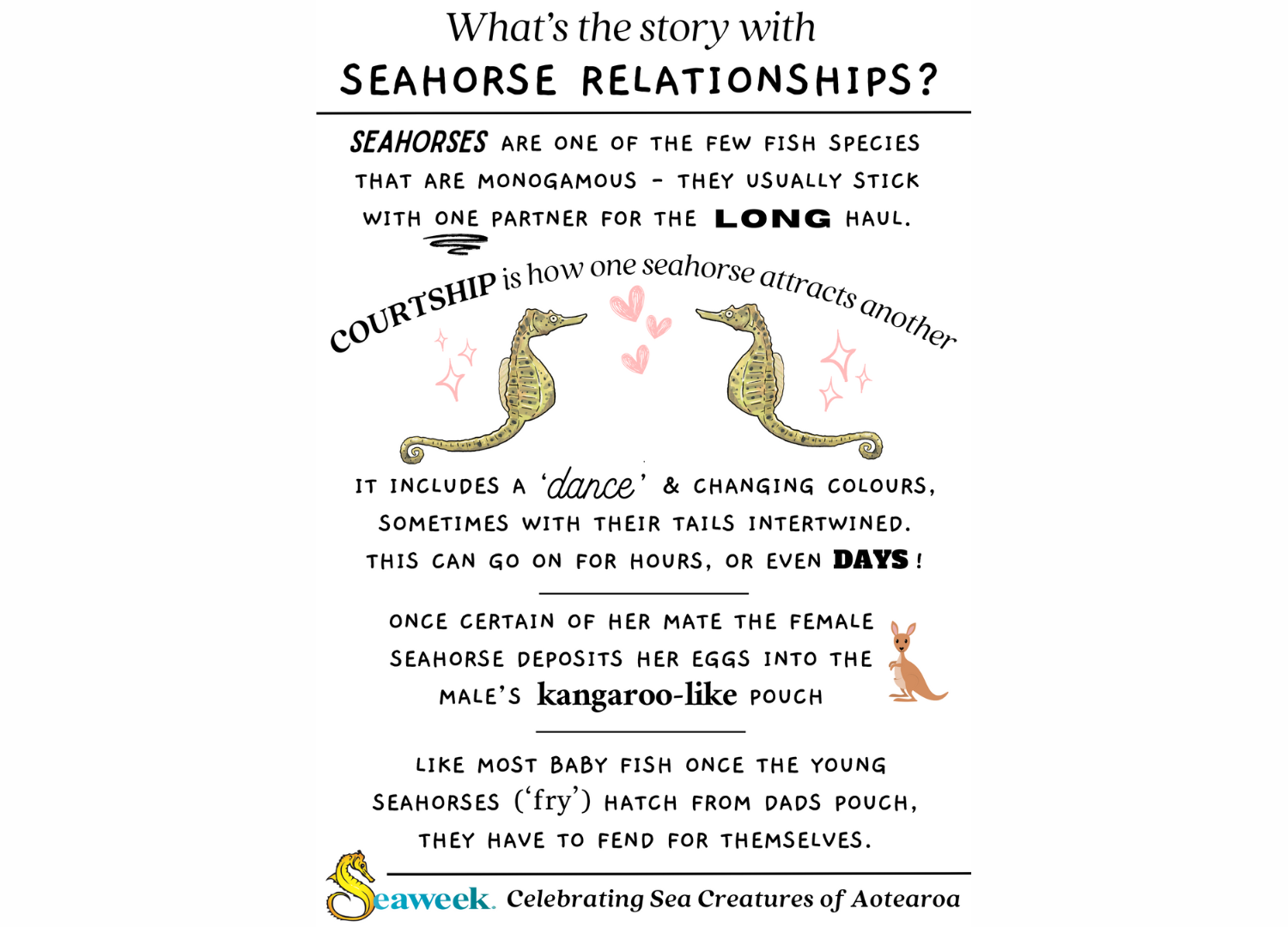
Gain insight into the life of the mysterious seahorse in this first of our series of conversations with sea creatures! They might be slow swimmers but they are good at hiding!
Did you know that male seahorses have egg-carrying abilities? Find out more in this interview, through our downloadable creature card and the links further below.
Q. Hi Mr. Seahorse, Can you tell us a little about yourself?
A. I am the world’s largest known seahorse species, growing up to 35cm in size! I am also known as the big-belly or pot-belly seahorse, or manaia in te reo Māori. Scientists call me Hippocampus abdominalis. This fancy name is because I belong to the genus Hippocampus, which is a combination of the Greek words for horse (híppos) and sea monster (kámpos).
Q. Where's the ultimate seahorse hideout?
A. You can find me blending in amongst seaweed and seagrass habitats throughout many coastal areas around New Zealand and Australia.
Q. What is your favourite food?
A. Tiny crustaceans, like shrimp, and zooplankton, drifting organisms that cannot swim against currents. They need to be small since I have no teeth. Instead of chewing, I use a suction technique to slurp them up and break them down in my throat. Without a stomach for food storage, I must munch frequently to stay fuelled.
Q. What makes you unique from other fish species?
A. Unlike other fish, seahorses have real style. We cruise upright, our dorsal fin provides propulsion and we use pectoral fins for steering. Now, about tails mine's not just for show. It's prehensile, a fancy word for saying I can grab and hold onto things.
Q: What's the story with seahorse relationships?
A. We seahorses are one of the few fish species that stick with one partner for the long haul. Our courtship can involve intertwining tails and colour-changing - and sometimes this goes on for hours or even days! The finale is when the female seahorse transfers her eggs into the male’s kangaroo-like pouch, quite the feat for a fish! But don’t let this move fool you. we're still a lot like other fish when it comes to parenting, once the baby seahorses, called 'fry', hatch, they have to fend for themselves.

Q. Any cool tricks up your seahorse sleeve for survival?
A. Being able to camouflage and blend into my surroundings is a huge help since I can’t outswim predators. My exoskeleton of bony plates is covered in chromatophores, specialised colour-changing cells. Plus, my eyes are like independent explorers, each doing their own thing and letting me see in every direction.
Q. What do most people not know about you?
A. Humans know very little about our abundance and behaviour in the wild. While we are protected by law globally, we still face some serious underwater drama. Our homes are under threat from human actions; destruction of habitats through coastal development, pollution and trawling. On top of that, there's always the risk of becoming fishing bycatch, or being poached due to our popularity in the pet trade, as decorations, and as medicinal ingredients in some parts of the world. Our lives are still mostly a mystery - but we can't reveal it all in one interview.
View PDF of Seahorse 'Creature Card'
Designed to download, print & display with your poster
Visit these sites to learn more:
- How & What Seahorses Eat: oceanfauna.com/how-and-what-do-seahorses-eat
- Worldwide Seahorse Conservation project: projectseahorse.org/saving-seahorses
- Citizen Science reveals species distribution: inaturalist.org/projects/iseahorse
- NZ Geographic Article: nzgeo.com/stories/the-endearing-endangered-seahorse
- Fun Facts About Seahorses: scuba.com/blog/10-fun-facts-about-seahorses
Take our quick quiz to test your knowledge!
-1706129066-COPY.png)